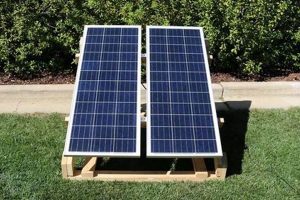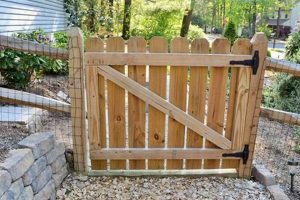The process of independently constructing a water well, using manual labor and/or mechanical assistance, to access groundwater resources is an undertaking that individuals may consider for various reasons. This involves procuring necessary tools, understanding geological conditions, and adhering to local regulations. Examples range from using simple hand augers in areas with soft soil to employing more sophisticated drilling rigs for deeper and more complex formations.
The significance of accessing independent water sources lies in the potential for cost savings, increased self-sufficiency, and access to water in areas where municipal supplies are unavailable or unreliable. Historically, the ability to extract water from the ground has been crucial for settlement and agricultural development. This practice, when carried out responsibly, can enhance water security for individuals and communities.
The subsequent discussion will explore the multifaceted aspects of independently creating a water source, encompassing the required equipment, essential safety precautions, relevant legal considerations, and potential challenges encountered during the process. It will also detail the varying methods available and best practices for successful implementation.
Essential Guidelines for Independent Water Source Development
Successful independent water source construction requires careful planning, meticulous execution, and a thorough understanding of hydrogeology and safety protocols. The following guidelines provide essential insights for those undertaking such a project.
Tip 1: Conduct a Thorough Site Assessment: Prior to commencing any physical work, a comprehensive evaluation of the proposed drilling location is paramount. This involves analyzing soil composition, identifying potential geological hazards, and determining the depth of the water table. Consult local geological surveys for relevant data.
Tip 2: Adhere to Local Regulations and Permitting Requirements: Independent water source development is often subject to stringent regulations at the local, regional, and national levels. Thoroughly research and comply with all applicable permitting requirements before initiating any drilling activities. Failure to do so can result in fines and legal repercussions.
Tip 3: Select Appropriate Drilling Equipment: The choice of drilling equipment should be dictated by the geological conditions of the site. Augers are suitable for soft soils, while more robust drilling rigs are necessary for harder formations. Ensure that all equipment is properly maintained and operated according to the manufacturer’s instructions.
Tip 4: Prioritize Safety: Water source construction inherently involves risks. Wear appropriate personal protective equipment (PPE), including safety glasses, gloves, and steel-toed boots. Secure the drilling site to prevent unauthorized access and potential injuries. Have a comprehensive safety plan in place to address potential emergencies.
Tip 5: Implement Proper Well Casing and Screening: The installation of appropriate well casing and screening is crucial for preventing contamination and ensuring long-term well performance. Select materials that are compatible with the water chemistry and soil conditions. Properly seal the annulus between the casing and the borehole to prevent surface water infiltration.
Tip 6: Develop the Well Effectively: After drilling and casing installation, the well must be developed to remove sediment and optimize water flow. Employ appropriate well development techniques, such as surging or airlifting, to maximize yield and minimize the risk of pump damage.
Tip 7: Conduct Water Quality Testing: Before using the water for potable purposes, it is essential to conduct comprehensive water quality testing. Analyze samples for bacteria, heavy metals, and other contaminants to ensure that the water meets established safety standards. Implement appropriate treatment measures if necessary.
These guidelines are intended to provide a framework for responsible independent water source development. Diligent planning, adherence to safety protocols, and compliance with regulations are essential for successful implementation and long-term sustainability.
The subsequent sections will delve into specific methods, troubleshooting techniques, and long-term maintenance strategies for independent water sources.
1. Planning and preparation
Effective independent water source construction is contingent upon meticulous planning and thorough preparation. Insufficient planning can lead to project failure, cost overruns, environmental damage, and potential safety hazards. A well-defined plan serves as a roadmap, guiding the entire process from initial site assessment to final water quality testing. As an example, failing to adequately research local hydrogeology prior to drilling can result in a dry well or one that yields insufficient water for intended purposes. Moreover, neglecting to secure necessary permits can lead to legal penalties and project delays.
The planning phase involves several critical components, including a detailed site assessment to determine soil composition and water table depth, selection of appropriate drilling equipment based on geological conditions, and development of a comprehensive safety plan to mitigate potential risks. It also encompasses securing all necessary permits and ensuring compliance with local regulations. For instance, if the intended use of the water is for human consumption, the plan must include provisions for regular water quality testing and appropriate treatment measures to address potential contaminants. Accurate cost estimation and budgeting are also crucial, as unexpected expenses can derail the project.
In summary, the connection between meticulous planning/preparation and successful independent water source establishment cannot be overstated. Thorough due diligence minimizes risks, optimizes resource allocation, and enhances the likelihood of a sustainable and safe water supply. The time and effort invested in comprehensive planning are invariably repaid in the form of reduced complications, improved project outcomes, and long-term operational efficiency. Neglecting this crucial phase compromises the entire endeavor.
2. Equipment selection
Equipment selection is a foundational element in independent water source creation, directly influencing the success or failure of the endeavor. The geological profile of the drilling site is a primary determinant in equipment choices. For instance, unconsolidated sandy soils necessitate different equipment than hard rock formations. Utilizing an auger intended for soft soils in a rocky substrate would prove ineffective and potentially damage the equipment. Conversely, employing a large, expensive drilling rig in a location suitable for a hand auger represents a significant waste of resources. The correc
t selection translates to efficiency, reduced risk of equipment failure, and minimized project timelines.
Various drilling methods, each requiring specific equipment, are available. Hand augers, suitable for shallow depths and soft soils, are the most basic option. Powered augers offer increased drilling speed and depth capabilities in similar conditions. Rotary drilling rigs, utilizing a rotating drill bit and drilling fluid, are capable of penetrating harder formations and achieving greater depths. Air hammer drills, employing compressed air to power a reciprocating hammer, are optimal for extremely hard rock. The improper choice can lead to insurmountable challenges. An undersized pump, for example, will not provide sufficient water pressure, and an incorrectly sized drill bit will prevent proper casing installation, potentially contaminating the water source.
Ultimately, informed equipment selection is paramount for safe and efficient independent water source construction. A thorough understanding of the geological conditions, drilling methods, and equipment capabilities is critical. This knowledge allows for the selection of appropriate tools, minimizing risks, optimizing project timelines, and ensuring a sustainable and reliable water supply. Failure to carefully consider equipment requirements can lead to project delays, cost overruns, equipment damage, and, in extreme cases, complete project failure.
3. Safety protocols
The implementation of rigorous safety protocols is non-negotiable in independent water source development. The inherent risks associated with drilling equipment, geological instability, and potential exposure to hazardous materials necessitate a proactive and comprehensive approach to safety management. Neglecting these protocols can result in serious injury, property damage, and environmental contamination.
- Personal Protective Equipment (PPE)
The consistent use of appropriate PPE is fundamental. This includes, but is not limited to, safety glasses to protect against flying debris, gloves to prevent skin contact with drilling fluids and contaminants, steel-toed boots to safeguard against foot injuries, and hearing protection to mitigate noise exposure from drilling equipment. The failure to wear PPE significantly increases the risk of injury from common hazards present at drilling sites.
- Site Hazard Assessment and Mitigation
A thorough assessment of the drilling site for potential hazards is essential before any work commences. This includes identifying unstable ground conditions, overhead power lines, buried utilities, and potential sources of contamination. Appropriate mitigation measures, such as shoring unstable ground, maintaining safe distances from power lines, and contacting utility companies to mark buried lines, must be implemented to minimize risks.
- Equipment Operation and Maintenance
Proper training in the safe operation of all drilling equipment is crucial. This includes understanding the equipment’s limitations, following manufacturer’s instructions, and performing regular maintenance to ensure it is in safe working condition. Defective or improperly operated equipment can lead to accidents, including equipment malfunction, uncontrolled releases of drilling fluids, and physical injuries.
- Emergency Response Planning
A comprehensive emergency response plan must be in place to address potential incidents, such as equipment failures, injuries, or environmental spills. The plan should include clear communication protocols, designated emergency contact numbers, first aid procedures, and spill containment measures. Regular drills should be conducted to ensure that all personnel are familiar with the plan and can respond effectively in an emergency situation.
The integration of these safety facets into every stage of independent water source construction is paramount. Prioritizing safety not only protects individuals from harm but also safeguards property, the environment, and the long-term viability of the water source. A culture of safety, emphasizing proactive risk management and continuous improvement, is indispensable for responsible independent water source development.
4. Permitting compliance
Independent water source development is intrinsically linked to regulatory frameworks mandating permits for drilling activities. Non-compliance with permitting requirements can result in significant legal and financial repercussions, including fines, project shutdowns, and mandates to decommission improperly constructed wells. Permitting processes ensure adherence to established standards that protect groundwater resources, prevent contamination, and safeguard public health. These regulations often stipulate minimum well construction standards, water quality testing protocols, and reporting requirements, all designed to minimize environmental impact and ensure sustainable water resource management. For instance, some jurisdictions require a detailed hydrogeological assessment prior to granting a permit, to evaluate the potential impact of the well on surrounding aquifers.
The absence of proper permits can lead to several adverse outcomes. Unregulated drilling activities may result in the contamination of groundwater sources due to inadequate well sealing or improper disposal of drilling fluids. The introduction of surface pollutants into the aquifer can render the water unusable and pose a significant threat to human health and the environment. In areas with limited water resources, unpermitted wells can also contribute to over-extraction, depleting aquifers and causing water shortages for existing users. Consider a scenario where an individual constructs a well without a permit and fails to properly seal the well casing. This can create a direct pathway for surface runoff, carrying pollutants such as pesticides and fertilizers, to enter the groundwater supply, contaminating the drinking water for nearby residents.
Therefore, thorough understanding and adherence to permitting requirements are crucial for responsible independent water source development. Engaging with local regulatory agencies, conducting thorough research, and submitting complete and accurate permit applications are essential steps. Ignoring or circumventing these processes not only exposes individuals to legal risks but also undermines the sustainability of water resources and jeopardizes public health. Proper permitting compliance, while potentially adding time and complexity to the project, ultimately contributes to the long-term viability and responsible management of groundwater resources.
5. Geological knowledge
Geological knowledge constitutes a cornerstone of successful independent water source development. The subsurface environment is heterogeneous, and an understanding of geological formations, hydrogeological characteristics, and potential subsurface hazards is paramount for locating and constructing a productive and sustainable well. Without this knowledge, the likelihood of drilling a dry well, encountering subsurface obstacles, or inadvertently contaminating the aquifer significantly increases. The geological composition directly influence
s drilling methods, equipment selection, and well design. For instance, drilling through fractured bedrock requires different techniques and equipment compared to drilling through unconsolidated sand and gravel deposits. Similarly, the permeability and porosity of geological formations dictate the potential yield and recharge rate of the well.
The practical application of geological knowledge is evident in various stages of the independent water source process. Prior to drilling, a detailed site assessment should include a review of geological maps, well logs from nearby properties, and geophysical surveys to characterize the subsurface conditions. This information helps to identify potential aquifers, estimate drilling depths, and anticipate potential challenges such as encountering impermeable layers or geological faults. During drilling, continuous monitoring of the drilling cuttings provides valuable insights into the changing geological formations and can help to optimize drilling parameters. The identification of clay layers, for example, may necessitate adjustments to drilling techniques to prevent borehole collapse. After drilling, geological knowledge is essential for selecting appropriate well casing and screen materials, designing the well development process, and interpreting water quality data. Understanding the geological composition of the aquifer helps to predict the potential for corrosion, scaling, or other water quality issues.
In conclusion, geological knowledge is not merely an academic exercise but a practical necessity for anyone undertaking independent water source construction. A thorough understanding of subsurface conditions minimizes risks, optimizes well design, and enhances the long-term sustainability of the water supply. While it may be tempting to proceed without adequate geological information, doing so significantly increases the potential for costly mistakes, environmental damage, and ultimately, a failed well. Integrating geological expertise into the planning and execution of independent water source projects is therefore essential for ensuring a reliable and safe water supply.
6. Well Development
Well development is a crucial phase in independent water source construction, particularly relevant in the context of “diy well drilling.” It follows the drilling and casing installation stages and is essential for optimizing well performance and ensuring a sustainable water supply. This process involves removing fine particles and sediment from the wellbore and the surrounding aquifer, thereby improving hydraulic conductivity and increasing water yield. The effectiveness of well development directly impacts the long-term productivity and efficiency of the water source.
- Removal of Drilling Effluent
The drilling process inevitably introduces fine particles, such as clay and silt, into the wellbore and the adjacent aquifer. These particles can clog the pores of the aquifer, reducing its permeability and hindering water flow. Well development techniques, such as surging and airlifting, are employed to dislodge and remove these materials, creating a more efficient pathway for water to enter the well. For example, a diy well drilling project might utilize a surge block to force water in and out of the well screen, effectively loosening and removing accumulated sediment. Failure to adequately remove drilling effluent can result in a significantly reduced well yield and increased pumping costs.
- Enhancing Hydraulic Conductivity
Well development aims to improve the hydraulic conductivity of the aquifer surrounding the wellbore. Hydraulic conductivity is a measure of the aquifer’s ability to transmit water. By removing fine particles and increasing pore space, well development creates a more permeable zone around the well, allowing water to flow more freely. In diy well drilling scenarios, this can be achieved through techniques like overpumping, where the well is pumped at a higher rate than its sustainable yield to draw water from a larger area of the aquifer. A higher hydraulic conductivity translates to a greater water yield and a more reliable water supply.
- Stabilizing the Wellbore
Well development contributes to the stabilization of the wellbore by consolidating the formation around the well screen. This process prevents the collapse of the wellbore and minimizes the risk of sediment entering the well after development is complete. Techniques like gravel packing, where a layer of gravel is placed around the well screen, can further enhance wellbore stability. In diy well drilling, ensuring a stable wellbore is crucial for preventing well failure and maintaining water quality over the long term. Without proper stabilization, the well can become clogged with sediment, requiring costly repairs or even abandonment.
- Water Quality Improvement
Well development can improve water quality by removing fine particles and organic matter that may be present in the aquifer or introduced during the drilling process. These materials can contribute to turbidity, color, and odor problems in the water. Well development techniques, such as pumping and filtering, can help to remove these contaminants, resulting in clearer and more palatable water. In diy well drilling projects, careful attention to water quality during well development is essential for ensuring that the water is safe for its intended use, whether it be for drinking, irrigation, or other purposes.
These facets underscore the critical role of well development in independent water source creation. In the context of “diy well drilling,” a thorough understanding and execution of well development techniques are essential for achieving a productive, sustainable, and reliable water source. Neglecting this phase can lead to significant problems, including reduced well yield, increased pumping costs, water quality issues, and even well failure. Therefore, proper well development is an investment that pays dividends in the form of a long-lasting and efficient water supply.
7. Water Quality
Water quality is a paramount consideration in independent water source development, especially within the context of “diy well drilling.” The safety and suitability of the water for its intended use, whether for potable consumption, irrigation, or industrial applications, hinges directly on its chemical, physical, and biological characteristics. Due diligence in water quality assessment and management is therefore non-negotiable.
- Contamination Pathways
Independent water sources are vulnerable to various contamination pathways, including surface runoff, subsurface migration of pollutants, and improper well construction practices. “diy well drilling” projects, in particular, require careful attention to well sealing and casing installation to prevent surface water infiltration. Examples include improper disposal of drilling fluids, proximity to septic systems or agricultural land, and naturally occurring contaminants such as arsenic or radon. The consequences of failing to address these pathways can range from short-term health issues to long-term chronic illnesses.
- Testing and Analysis
Comprehensive water quality testing is essential to determine the presence and concentration of contaminants. Standard tests typically include analysis for bacteria (e.g., E. coli), nitrates, heavy metals (e.g., lead, mercury), and vo
latile organic compounds (VOCs). The frequency of testing should be determined based on the intended use of the water, potential sources of contamination, and local regulations. In the context of “diy well drilling,” it is prudent to conduct baseline testing immediately after well development and periodic monitoring thereafter. Certified laboratories should be utilized to ensure accurate and reliable results. - Treatment Options
Based on the results of water quality testing, appropriate treatment methods may be necessary to remove or reduce contaminants to acceptable levels. Treatment options vary depending on the type and concentration of contaminants, as well as the intended use of the water. Common treatment methods include filtration, disinfection (e.g., chlorination, UV irradiation), and reverse osmosis. “diy well drilling” projects may require the installation of point-of-entry or point-of-use treatment systems, depending on the specific water quality challenges. Regular maintenance and monitoring of treatment systems are essential to ensure their continued effectiveness.
- Regulatory Compliance
Water quality standards for independent water sources are often governed by local, regional, or national regulations. These regulations may specify maximum contaminant levels (MCLs) for various substances and require periodic testing and reporting. In “diy well drilling” scenarios, it is imperative to understand and comply with all applicable regulations to ensure that the water source meets established safety standards. Failure to comply can result in legal penalties and potential health risks to consumers of the water.
The intersection of water quality and “diy well drilling” underscores the importance of responsible and informed practices. From identifying potential contamination pathways to implementing appropriate testing, treatment, and monitoring strategies, a comprehensive approach to water quality management is essential for ensuring a safe and sustainable water supply. The long-term health and well-being of those relying on the water source depend on diligent attention to water quality throughout the entire independent water source lifecycle.
Frequently Asked Questions about Independent Water Source Construction
The following questions and answers address common concerns and misconceptions regarding the establishment of an independent water source, specifically when considering a do-it-yourself approach.
Question 1: Is independent water source construction permissible in all locations?
Regulatory frameworks governing water extraction vary significantly by jurisdiction. Local authorities often impose restrictions on well drilling to protect groundwater resources, prevent over-extraction, and ensure water quality. A thorough investigation of local ordinances and permitting requirements is essential prior to commencing any drilling activity. Failure to comply with regulations can result in significant legal and financial penalties.
Question 2: What are the primary risks associated with a do-it-yourself approach to independent water source construction?
Undertaking independent water source construction without proper training and experience presents several risks. These include potential injury from heavy machinery, encountering subsurface geological hazards, contaminating the aquifer due to improper well sealing, and failing to achieve a sustainable water yield. Professional well drillers possess the expertise and equipment necessary to mitigate these risks.
Question 3: How can the potential for groundwater contamination be minimized during independent water source construction?
Preventing groundwater contamination requires meticulous attention to detail throughout the drilling and construction process. Proper well casing and sealing techniques are crucial to prevent surface water infiltration. Drilling fluids and waste materials must be managed and disposed of responsibly. Regular water quality testing is essential to monitor for potential contaminants and ensure the water is safe for its intended use.
Question 4: What factors influence the sustainable yield of an independent water source?
The sustainable yield of a well is determined by a combination of geological and hydrogeological factors, including the permeability and storage capacity of the aquifer, the recharge rate, and the proximity to other wells. Over-pumping can deplete the aquifer and lead to a decline in water levels. A professional hydrogeological assessment can help to estimate the sustainable yield and prevent over-extraction.
Question 5: What ongoing maintenance is required to ensure the long-term viability of an independent water source?
Independent water sources require regular maintenance to ensure their continued functionality and water quality. This includes periodic inspection of the well casing, pump, and associated equipment. Water quality testing should be conducted at regular intervals to monitor for changes in contaminant levels. Well development may be necessary periodically to remove sediment and maintain optimal water flow.
Question 6: What are the legal liabilities associated with independent water source construction?
Individuals undertaking independent water source construction may be held liable for damages resulting from their activities. This can include liability for groundwater contamination, property damage, or injuries sustained by third parties. Adequate insurance coverage is essential to protect against potential liabilities. Compliance with all applicable regulations is also crucial to minimize legal risks.
Independent water source construction, particularly using a do-it-yourself methodology, demands a thorough understanding of geological principles, regulatory requirements, and potential risks. Seeking professional guidance is advisable to mitigate these risks and ensure a sustainable and legally compliant water supply.
The subsequent section will delve into case studies illustrating successful and unsuccessful independent water source projects, highlighting lessons learned and best practices.
diy well drilling
The preceding exploration has elucidated the multifaceted aspects of independent water source development. The presented analysis underscored the necessity of geological knowledge, permitting compliance, and rigorous safety protocols. Improperly executed independent water source installation, notably within the sphere of “diy well drilling,” poses potential risks to individual well-being, environmental integrity, and legal standing. The discussion emphasized the critical role of well development in optimizing water yield and the imperative of consistent water quality monitoring to ensure a safe and sustainable water supply.
Responsible engagement with independent water source construction necessitates careful consideration of the presented insights. Prospective individuals must judiciously evaluate their expertise, assess the inherent risks, and prioritize adherence to established best practices. The ultimate decision concerning independent water source establishment should reflect a commitment to responsible water resource management, regulatory compliance, and the long-term welfare of the community and the environment.







